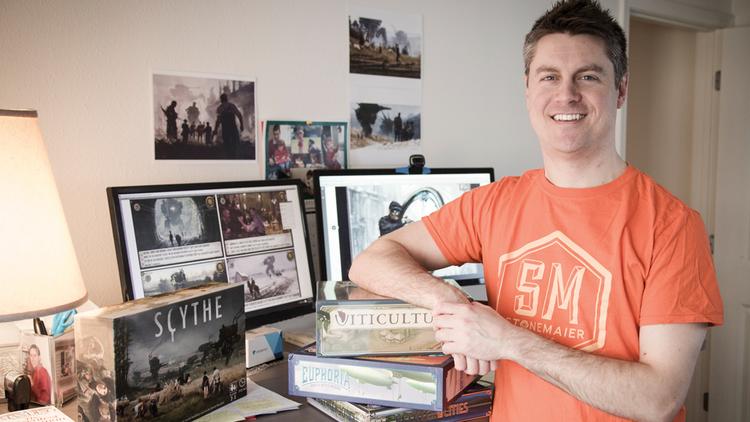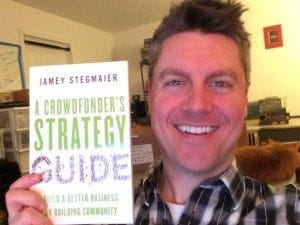Nowadays it seems like we are taught to see conspiracy in everything. The bunnies whisper to each other about me, I know it.
And what of the mailman! What secret and sinister agenda is he plotting? The Postal Services? HA! No, NextDoor told me my neighborhood mailman, Bryce, is an agent of COBRA.
So when I play Stonemaier board games like Viticulture [1] Euphoria, or Wingspan, the truth simply can’t be that those games really are as beautifully designed and fun to play as they appear to be.
And when I read the personal blog of the co-founder of Stonemaier Games, Jamey Stegmaier, it simply must be fake news that he’s as professional, kind, thoughtful, and generous as he appears to be. Although HYDRA will never waver a bastion of truth like Steve Rogers, I will not be tricked by the tricks of Jamey Stegmaier!
So, I captured Jamey and brought him back to Nerds on Earth HQ in order to discover the real truth! He was questioned thoroughly, then released unharmed.

Talking about Board Games: An Interview with Jamey Stegmaier
Clave: Jamey, what’s your origin story as a game designer?
Jamey: I started designing games when I was pretty young—maybe 7 or 8 years old. Most of my games back then were knock-offs of other games I was playing at the time.
As an adult, I returned to game design when my friends introduced me to Settlers of Catan, for which I designed an expansion. That rekindled the passion from my youth, and a few years later I started working on Viticulture.
Clave: Wow, prototypes from 7-year-old-Jamey might be a hot commodity on the board game black market! When did you know you were taking it full time?
Jamey: When Euphoria raised $309k on Kickstarter and I was basically working a full-time day job plus full-time for Stonemaier, I asked my day-job boss if I could take a 20% pay cut and only work 4 days a week. He agreed. A few months later I decided to try to really go full-time for Stonemaier, with the personal goal that if it didn’t work out in 1 year, I’d join the regular workforce again.
Clave: Do you ever just pinch yourself because you have the best job in the world?
Jamey: I should do that more often, as I may take it for granted that I get to do what I love every day. One thing that surprised me about working for myself and from home is that it’s really hard to draw a line between work and everything else.
That is, it’s very easy to have a day where I wake up, start working, and don’t stop until I go to bed. Sometimes that’s a good thing, but sometimes I found that taking intentional breaks is important for my emotional wellbeing.
Clave: I hear you. I work from home as a consultant. There’s no Flintstones-style closing whistle, that’s for sure. What are a couple things that others might be surprised about as it relates to starting your own business?
Jamey: From a more business-centric perspective, I’ve learned how important it is to pay accurate quarterly income tax instead of waiting until the end of the year. It’s pretty much the same in the eyes of the government, but it’s much easier to manage cash flow when you’re removing chunks over time instead of a lump sum during tax season.
Clave: Same here. Quarterly is the way to go. Otherwise, it can sneak up on you quick. From concept to table is obviously a very lengthy and complicated journey. What’s a rough time breakdown of your game design process?
Jamey: Here’s the list in sequential order: idea, brainstorming, prototyping, rule writing, playtesting with my business partner, revisions, playtesting with friends/locals, revisions, worldwide blind playtesting, proofreading, final file review.
Clave: Can you give us a little teaser as to what might be coming next?
Jamey: The things I’ve announced are the release of Between Two Cities: Capitals in July, an expansion for Between Two Cities that adds several new challenges to the game.
Charterstone comes in late October. [2] This will be a legacy style game where players build a village. And Scythe: The Wind Gambit is the next expansion for Scythe [3]. It brings airships to the game and drops in November.
We’re also publishing a game from an outside designer (sometime in 2018), and I’m currently at various stages of design for 4 games (maybe 1-2 of them will ever see the light of day). [4]
Clave: I need to own all those things!
You are known as one of the most thoughtful and generous people in the board game hobby. Why is it so important to you to share your learnings and experiences on your blog and other places?
Jamey: Well, it started with me wanting to add value to other people through the content I create (my crowdfunding blog and my game design YouTube channel), and that desire continues to this day. Also, I process things best by writing or talking about them, so compiling my thoughts really helps me too. [5]
Clave: What are the elements and principles you aim for in every game you design or produce?
Jamey: One is flow. I always look for ways to let players forget that they’re in a game and really immerse themselves in the “magic circle.” That’s why turns in my games typically involve a one or two quick decisions for which you can plan ahead, and I try to avoid using rounds and phases.
The other I’ll mention is that while I try really hard to create strong connections between mechanisms and the theme of a game, the most important thing to me is that the game is fun. So if there’s something thematically accurate that is frustrating or boring for players, I’d rather make it less accurate and increase the fun.
An example of this is Riverwalk in Scythe. Yes, it would make more sense that after gaining that ability your mechs and character could walk freely across any river. But blind playtesting revealed that it was super frustrating to other players to have an opponent walk into their home area on turn 4. [6]

Clave: Why do you think the board game hobby has seen such continued growth over the last several years? What is it about board gaming that is resonating with so many?
Jamey: I think it varies from person to person, but a vast generalization is that I think people find value in an opportunity to turn off the many screens in our lives and focus on something tangible. As for its huge growth over the last few years, I think a big part of it may be Kickstarter, some part of it may be attributed to the varied supporting content (YouTube, podcast, and blog), and part of it may be related to the cyclical nature of gaming: If parents play games with their kids, those kids may grow up to be gamers and play with their kids, and so on.
Clave: Where do you think the industry is going in the next five years?
Jamey: The one thing I can think of is that we’re in an era when it’s possible—and often cost-effective—to make pretty much any component. So I think we’re going to see some pretty cool components in games.
Clave: What else are you nerding out on?
Jamey: I’ll choose one thing per category: An Ember in the Ashes (book), Wonder Woman (movie), Better Call Saul (TV), Generationals (music)
Clave: Jamey, thanks so much. Your reputation of being one of the very best humans in the board gaming industry is much deserved! All the best to you. [7]
- Here’s our review of Viticulture. It’s a wonderful game.
- Charterstone is going to be HUGE, folks.
- Scythe is currently ranked as the #7 board game of all time, nerds. It’s legit.
- Learn more about what’s coming up from Stonemaier here.
- Here’s the Stonemaier blog. It’s thoughtful, informative, and one of the best places to fill your brain with the “business” of board gaming.
- You should really check out the full list of design principles for Stonemaier Games. Good stuff.
- Goodness, Jamey Stegmaier really is a great guy. But my neighborhood mailman on the other hand…

